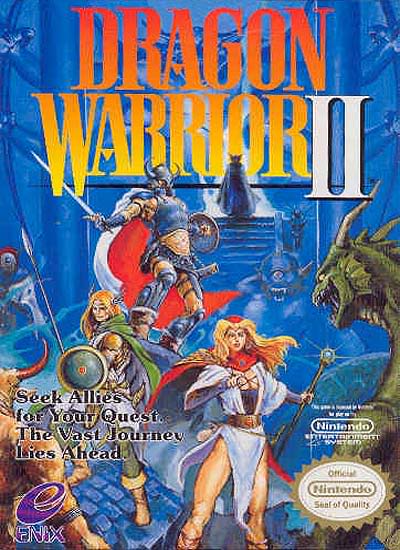 Remember that NES game that had you taking a nameless protagonist through a massive world in the hopes of defeating the nefarious Dragon Lord? Yeah? Well if you’re like me, you probably don’t look back on that experience fondly.
Remember that NES game that had you taking a nameless protagonist through a massive world in the hopes of defeating the nefarious Dragon Lord? Yeah? Well if you’re like me, you probably don’t look back on that experience fondly.
Every time I took a step in the world of Dragon Quest, I dreaded the possibility of another mundane battle. Dragon Quest’s monotony was enough to make me feel like a crotchety old man, so I was relieved once that tedious experience finally ended.
With such a lousy experience, you’d think that I wouldn’t touch Dragon Quest’s sequel, but my curiosity got the best of me. My inner-RPG fan desired to experience the early years of Dragon Quest, so I gave number two a shot.
When I booted up Dragon Quest 2, I witnessed a title screen that was more than a solid black background accompanied by a title, so I had a feeling that I was in for an improved experience. What I observed after inputting my character’s name confirmed that.
[video:http://www.youtube.com/watch?v=HOrfzFPZLAs 425×25]
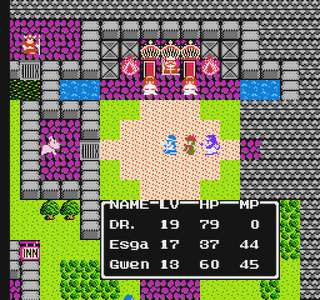
Dragon Quest 2 opened with an impressive story sequence (for an early NES title) depicting the evil wizard Hargon conquering one of the world’s many kingdoms. The king nobly sacrificed himself in order to let the princess escape and warn other lands of Hargon’s impending reign of terror. However, the game didn’t truly begin until after this sequence.
As with the first Dragon Quest, the player controls a blue hero, but this time he’s a descendant of the hero of the first game, which also technically makes him a descendant of Erdrick. This silent hero is similar to the protagonist of the original Dragon Quest, but this time he’s strictly a physical powerhouse.

To make up for his lack of magical abilities, the hero encounters other party members during the early hours of his quest. The first party member he encounters is a prince named Lars who has average physical abilities and decent healing and offensive spells. Shortly after meeting Lars, the hero meets a princess named Ollisa who’s the Dragon Quest series’ first female character. She can cast a variety of powerful spells, but unfortunately her physical abilities are rather limited.
Once you have your party of Norwegian joke book characters, the adventure becomes much more interesting. Your party spends the majority of its time traveling between towns and dungeons, and it’ll often be embroiled in random battles that are more enjoyable with additional party members. Unlike the first Dragon Quest, multiple enemies appear on-screen, so having more than one party member is practically a necessity.

Dragon Quest 2’s battles take up an entire screen unlike the first Dragon Quest, and the background is pitch-black instead of terrain-based. Once in battle, characters have similar commands to what was available in the first game such as ‘Fight’, ‘Magic’, ‘Item’, and ‘Flee’. These commands are self-explanatory for RPG fans, but this time there are additional spells that improve on Dragon Quest’s rudimentary magic system.
Elemental weaknesses don’t really come into play unlike in Final Fantasy’s battles, but regardless, there are still a number of elemental spells available, which are far more interesting than the poorly named spells from the original Dragon Quest. Some old spells make repeat appearances, but the new ones (especially the debuff and buff spells) are the most interesting.
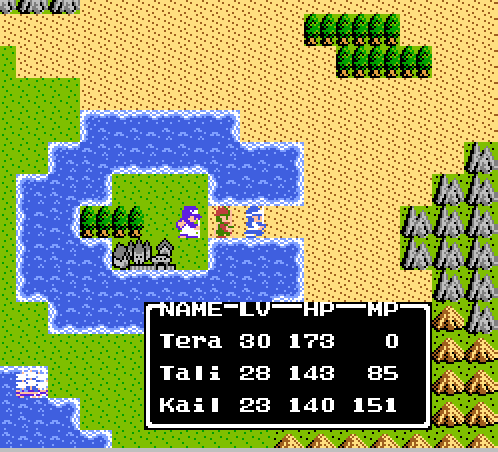
Other than some new spells and multiple party members, Dragon Quest 2’s battles really didn’t change that much from the original. Battles generally run at a quicker pace and they’re a little less frequent, but they’re still fairly elementary. It’s worth noting, however, that battles are generally a bit easier, and therefore require less grinding.
The original Dragon Quest was notorious for the hours you had to spend grinding before moving on to a new town, so fortunately, Dragon Quest 2 remedies that problem…until the final eight hours of the game. Grinding still exists to a lesser extent during the first fifteen hours, but at least your time spent hacking up monsters isn’t as long as a marathon.
Accompanying Dragon Quest 2’s early battles are numerous towns, castles, towers, and caves. The game’s towns look similar to those of the original Dragon Quest, but this time there are more key doors to unlock. These keys are necessary for completing Dragon Quest (unless you gain an absurd amount of levels early in the game), so it’s important to search everywhere for these essential items. They’re typically hidden in unusual locations, so a FAQ may be required for most players.
Besides these locked doors, Dragon Quest’s towns generally have a person that’ll record your progress along with a healer who is necessary for revival until you learn high level spells. You’ll be visiting these fine individuals regularly while in towns, but you’ll also want to peruse the game’s many weapon, item, and armor shops.
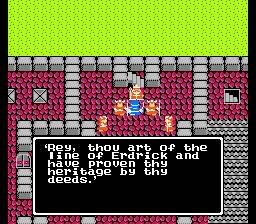
When you purchase equipment in Dragon Quest 2, it won’t be equipped automatically, so you’ll have to guess which pieces of equipment are optimal and equip them yourself. Once you’ve fully outfitted your characters, you can speak with villagers who spout nonsensical (though sometimes humorous) dialogue and play the lottery.
Towns are only a minor part of the adventure, however. The majority of the player’s time is spent in caves and towers that are a significant improvement over the dark caves of the original. In Dragon Quest 2, players explore completely lit environments that actually begin to resemble their source material. These labyrinths can be annoying to explore at times due to their length, pits, and countless dead ends, but at least they feel like monster nests.
Dungeons are certainly an important component of the Dragon Quest 2 experience, but you’ll also spend a significant amount of time searching for new lands. Instead of just walking as players did in the previous game, there are more convenient modes of transportation such as teleportation shrines and ships. The shrines quickly warp you to new locations, but they’re not as exciting as sailing the high seas.
While aboard your creaky wooden vessel, you’ll still engage in battle, but you’ll also be able to travel to previously inaccessible continents. Unfortunately, there’s no map to aid in navigating Dragon Quest 2’s poor world layout, but it’s still fun discovering new territories such as the continent of Alefgard, which fans of the original Dragon Quest will recognize.
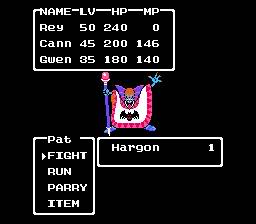
Dragon Quest 2 feels like a decent NES RPG experience all the way up until the crest-finding quest. During the latter portion of the game, the hero has to track down five crests that are necessary to open the path to the final dungeon. A few of these crests can be found through in-game clues, but some are so clumsily hidden that you’ll likely have to resort to a FAQ.
When the tedious crest-finding process is complete, a dungeon full of pits and dead ends open up that feels like a double punch to the kidney. Navigating this labyrinth is a pain, but once that process is complete, you’re awarded with a new area and additional grinding. Grinding during this final portion of the game isn’t so bad, however, because enemies finally give you a reasonable amount of experience. After that, there’s an underwhelming final dungeon that concludes with a small surprise.
Even though Dragon Quest 2 often failed to entertain me, that doesn’t mean that it wasn’t a vast improvement over its predecessor. Dragon Quest 2 was an innovative RPG that introduced multiple party members, cut-scenes, and sea travel to console RPG fans around the globe in 1987 (1990 in the U.S.). It also cut down on the grinding that plagued the original, and offered an improved world and soundtrack. It’s a shame that Dragon Quest 2 was tarnished by tedious fetch quests towards the end, but at least the experience as a whole was far more rewarding than that of the original Dragon Quest.
Score: 5/10
Pros:
- A revamped battle system that allows for a party of three
- Dragon Quest 2’s dungeons have received a visual upgrade over the original
- Great world map themes
- Features a memorable introduction
Cons:
- There’re numerous fetch quests towards the end of the game
- Many important items and keys are randomly hidden
- No character development
- Plot lacks substance
*Want to see how Dragon Quest 2 fares when pitted against its older sibling, Final Fantasy 2? Then check out RPG Battle Royale: Round 2.
VentureBeat's mission is to be a digital town square for technical decision-makers to gain knowledge about transformative enterprise technology and transact. Learn More
